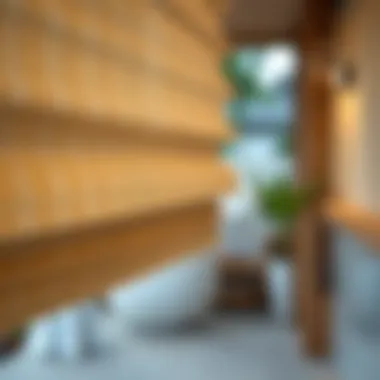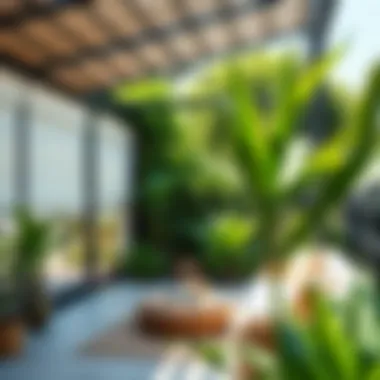Stylish White Bamboo Blinds for Outdoor Spaces


Intro
As the outdoors beckon us with their charm, finding the right balance between comfort and aesthetics becomes crucial for homeowners and design enthusiasts alike. Whether it's a cozy patio, a sprawling deck, or a sunny balcony, white bamboo blinds emerge as a versatile option that deserves the spotlight. Combining functionality with a refreshing design element, these blinds can elevate the outdoor ambiance while providing much-needed shade and privacy.
White bamboo blinds are not just about blocking out the sun; they bring an air of sophistication to any space. The light, airy feel of their design harmonizes wonderfully with the natural elements around, enhancing both the look and feel of your outdoor living areas. In this article, we will explore the myriad benefits of integrating white bamboo blinds into your outdoor settings and provide insights into their installation, maintenance, and overall appeal.
By examining aspects such as material sustainability, temperature control efficiency, and their positive impact on outdoor decor aesthetics, you’ll come away with a deeper understanding of why these beloved window coverings should feature in your next outdoor project.
Furniture Styles and Trends
Exploring Popular Furniture Styles
When discussing outdoor spaces, it’s essential to consider the style of furniture that pairs well with white bamboo blinds. Traditionally, outdoor furniture has leaned towards materials such as aluminum, wicker, and teak; however, there’s been a noticeable shift towards incorporating more eclectic choices to reflect individual taste.
- Bohemian: Characterized by vibrant colors, mismatched patterns, and an overall laid-back vibe, bohemian style meshes well with the natural texture of bamboo. A few colorful throw pillows on rustic chairs can transform an ordinary space into a whimsical retreat.
- Modern Minimalism: Clean lines and a neutral palette define this style. White bamboo blinds complement this aesthetic perfectly, offering both privacy and a sleek look that doesn’t overpower the setting.
- Industrial Chic: For urban dwellers, rich metals and raw wood can provide a stunning contrast to the softness of bamboo. Consider incorporating metallic accent tables to create a beautiful juxtaposition.
Understanding Current Design Trends
With a growing inclination towards eco-friendly design, bamboo products have found their way to the forefront. Homeowners are increasingly seeking sustainable materials, and white bamboo blinds fit the bill. They not only contribute to a stylish outdoor environment but do so while being kind to the planet. Here are a few trending concepts:
- Natural Elements: The trend of bringing the outside in continues to gain traction. Use wooden planters or stone accents along with your bamboo blinds to create a seamless connection between nature and style.
- Layering Textures: Mixing materials—like a soft rug underfoot, smooth fabrics, and the rough texture of bamboo blinds—adds depth and interest. It makes each element stand out while maintaining harmony in the design.
- Multi-Functional Spaces: As outdoor living areas evolve, combining lounging, dining, and entertaining areas is becoming the norm. White bamboo blinds can serve as room dividers, providing privacy without feeling enclosed.
"Designing outdoor spaces isn’t just about aesthetic; it’s about creating an experience where beauty and functionality coexist."
Incorporating these furniture styles and trends will help in maximizing the potential of your outdoor areas while enhancing the seamless integration of white bamboo blinds.
Preamble to White Bamboo Blinds
Outdoor spaces serve as a direct extension of our homes, a haven where we can unwind, entertain, or simply appreciate nature. In this context, the use of window treatments like white bamboo blinds has gained popularity, not just for their functional attributes, but for their stylish flair. White bamboo blinds offer a unique blend of flexibility, aesthetics, and ecological advantages, making them a noteworthy consideration for homeowners and designers alike.
The importance of understanding white bamboo blinds in outdoor areas can't be overstated. They deliver pivotal benefits, such as light control, privacy, and temperature regulation, which can enhance the overall experience in these spaces. Specifically, in an age where environmental consciousness is paramount, bamboo stands out as a sustainable choice. Its rapid growth and minimal resource requirement make it an attractive option compared to traditional materials.
Moreover, with the stylistic versatility of white bamboo blinds, they can complement various outdoor themes—from modern chic to classic rustic. By incorporating natural textures and hues, they create a calming ambiance that draws in the beauty of the outdoors while maintaining comfort.
Definition and Overview
White bamboo blinds, as the name suggests, are window coverings crafted from bamboo stalks that have been treated and dyed to achieve a white finish. This gives them an elegant appearance that brightens and visually enlarges outdoor spaces. In addition to their aesthetic appeal, bamboo material is lightweight yet remarkably sturdy, making it suitable for various weather conditions. Their slat design allows for adjustable light filtration while ensuring privacy without blocking air circulation, an essential factor for outdoor living.
In essence, white bamboo blinds not only act as a stylish accessory but also serve as practical solutions for sun-drenched patios, porches, or decks.
Historical Context
The use of bamboo as a building material stretches back thousands of years, with roots in ancient civilizations across Asia. Traditionally used in constructing homes and furniture, bamboo symbolizes strength and flexibility. It is particularly revered in Asian cultures, where it finds a place in various art forms and designs.
Adventurers exploring the dense jungles were often struck by bamboo’s resilience, prompting its incorporation into their shelters and everyday items. As societies evolved, so did the uses of bamboo, transitioning from its utilitarian origins into decorative forms. In recent decades, with increased interest in sustainable living, bamboo has reemerged as a favored material, and thus the advent of bamboo blinds, including the chic white variants, has become the trend in modern outdoor design.
Today, homeowners across the globe are rediscovering the beauty and functionality of bamboo, positioning it not just as a practical choice but also as a stylish element in outdoor decor. Its historical significance, combined with contemporary design trends, speaks to a broader movement toward sustainability in interior and exterior design.
Design Aspects of Bamboo Blinds
Understanding the design aspects of bamboo blinds is key to recognizing their appeal and utility in outdoor spaces. Bamboo blinds combine aesthetic charm with functionality, serving as something more than mere window coverings. They effectively bridge the gap between nature and architecture, providing both beauty and practicality. Their design goes beyond visual appearance, influencing light control, temperature modulation, and the overall ambiance of an outdoor living area. By examining various elements of these blinds, we can appreciate how they enhance outdoor experiences while adding a touch of elegance to any space.
Material Characteristics
Bamboo is a unique material, often celebrated for its strength-to-weight ratio. When it comes to bamboo blinds, the benefits of this material shine through. The fibers are both resilient and flexible, allowing the blinds to withstand outdoor elements, yet remain lightweight enough for easy handling. The natural texture of bamboo imparts a rustic charm, enhancing the organic feel of the surroundings. Additionally, the material is quite durable, resistant to warping and fading. This means homeowners can invest in white bamboo blinds with the confidence that they will maintain their look and function over time.
Moreover, bamboo is a natural insulator. During hot summer days, it assists in keeping spaces cooler, while in colder months, it provides a layer to trap warmth, making them efficient in temperature regulation—an important aspect for outdoor areas that connect to the home.
Color Variations
While the focus may often lie on white bamboo blinds, it’s crucial to understand the color variations available in this category. White bamboo blinds can come in various shades ranging from pristine white to warmer, off-white tones, which can complement different outdoor color schemes.
The subtle differences in these colors can influence how light interacts with the blinds throughout the day. For instance, true white reflects sunlight and makes a space feel airier, while warmer whites can create a more inviting atmosphere. Selecting the right shade can significantly enhance the appearance of patios or gazebos. Additionally, some manufacturers offer staining options, allowing for customized appearances while maintaining the natural aesthetic of bamboo. This flexibility presents homeowners with the chance to choose not just a function but a statement piece for their outdoor decor.


Patterns and Textures
The visual appeal of white bamboo blinds is elevated not just by their color but also by the patterns and textures found in the bamboo itself. Different manufacturing processes can result in various woven patterns, giving homeowners an array of styles to choose from. Some may prefer a simplistic, smooth look, while others might be drawn to intricate weaves that add character and depth.
Textural varieties can also add layers of interest to an outdoor setting. For example, a textured blind might play off the natural elements of a garden, like stone or wood structures, thereby tying together the overall design aesthetic. These details may seem small, yet they have a significant impact on how a space feels. It often seems that attention to these nuances can help tie various components of outdoor living spaces into a cohesive design.
Benefits of Using White Bamboo Blinds Outdoors
White bamboo blinds offer a myriad of advantages that can transform outdoor spaces. Homeowners, decorators, and designers are often on the lookout for solutions that balance aesthetics with functionality. The natural elegance of bamboo combined with the refreshing look of white creates a unique appeal. So, let's dig into the specific benefits white bamboo blinds present for outdoor settings.
Light Control and Privacy
One significant boon of utilizing white bamboo blinds is their ability to manage light and protect privacy. When set up properly, these blinds can filter sunlight, allowing a soft glow to filter through while blocking harsh rays that might make one squint. This makes outdoor spaces more welcoming for gatherings or quiet moments alike. Imagine hosting friends for an afternoon barbecue, the delightful sun shining through the slats, but without the glare.
Additionally, privacy is paramount for many homeowners. Being able to enjoy your outdoor retreat without prying eyes from neighbors can make a world of difference. White bamboo blinds offer a tasteful curtain that can adjust as needed. Just a slight tilt can hide you from view while still permitting light, creating an intimate atmosphere.
Temperature Regulation
Another reason white bamboo blinds are excellent for outdoor spaces is their role in temperature regulation. Bamboo itself is a natural insulator, making these blinds ideal for maintaining comfortable temperatures. During scorching summer days, they help block out intense sunlight, keeping sitting areas cooler. On the flip side, during cooler months, they can retain warmth from internal spaces, creating a cozy outdoor nook.
In practical terms, using white bamboo blinds can result in lower energy bills. By maintaining the internal temperature of your home or outdoor areas, there’s less reliance on heating or cooling systems, which can put a dent in overall energy consumption. This efficiency not only benefits your wallet but also the environment.
Aesthetic Value
The true charm of white bamboo blinds lies in their aesthetic appeal. They bring a touch of nature's simplicity into outdoor settings, merging seamlessly with plants, wood, and other natural elements. Their textured surface can add depth to an otherwise flat space, enhancing the overall look.
White carries connotations of cleanliness and freshness. When paired with green foliage or bright flowers, these blinds can help create a serene island effect in your backyard, patio, or porch. The contrast between the whites and vibrant colors of surrounding nature forms a picturesque scene.
Furthermore, bamboo blinds can serve as a perfect backdrop for outdoor furniture arrangements, art installations, or even hanging plants. They can instantly elevate a simple outdoor area into a stylish oasis.
"Incorporating white bamboo blinds into your outdoor design not only pleases the eye but celebrates the harmony between indoor comfort and outdoor bliss."
The elegance, functionality, and eco-friendliness of white bamboo blinds make them a fascinating consideration for anyone looking to upgrade their outdoor spaces. From controlling light to promoting aesthetics, their presence can significantly enhance the outdoor experience.
Installation Process
Installing white bamboo blinds correctly is a crucial step in enhancing both the functionality and beauty of your outdoor spaces. This process can significantly influence the overall aesthetics, light control, and even efficiency of temperature regulation. Getting it right can save you from future headaches, ensuring that your investment not only looks good but also serves its purpose effectively.
Preparation and Measurement
Before diving into the installation, proper preparation is your best friend. Start by measuring the window or outdoor space where the blinds will go. Here are some key steps to follow in this phase:
- Gather Your Tools: You'll typically need a tape measure, a pencil, a level, a drill, and mounting hardware. It’s wise to have everything close at hand before you begin.
- Measure Twice, Cut Once: Make sure to measure the width and height of your window or outdoor space accurately. Keep in mind if you're installing inside or outside the mount, as that can affect the size needed. Note these dimensions down correctly.
- Check the Level: Use a level tool to ensure that you are marking straight lines where the brackets will go. An uneven installation can lead to blinds that do not hang correctly or function as expected.
Mounting Techniques
Once you've prepped and measured accurately, it’s time to mount the blinds. Here’s where a few techniques can come in handy:
- Brackets Placement: Secure the mounting brackets at the marks you made earlier. It’s crucial to follow the manufacturer's instructions for where to install these brackets, as there can be variations depending on style and size.
- Use the Right Hardware: Ensure you’re using screws and anchors that match the specific wall material. Drywall, concrete, or wood all require different approaches.
- Slide in the Blinds: Once the brackets are set, you can slide the top rail of the bamboo blinds into place. Make sure to check that it's secure and level.
- Test for Smooth Operation: After installation, pull the blinds up and down to ensure smooth operation. Adjust if needed for any sticking or misalignment.
Finishing Touches
With the mounting completed, it’s time to add the finishing touches:
- Cords and Mechanisms: Make sure all cords are functioning correctly. If your bamboo blinds have a tilt or lift mechanism, double-check that these features work as designed.
- Final Adjustments: Take a step back and look at your blinds from different angles. Adjust their position slightly if they don’t look quite right.
- Clean as You Go: As bamboo can accumulate dust during installation, give them a quick wipe over with a soft cloth. This helps maintain their pristine, bright white look right from the get-go.
"A precise installation allows you to enjoy the elegance and functionality of bamboo blinds without enduring the nuisances of misalignment or irregular operation."
This installation phase ensures that your white bamboo blinds perform excellently while also enhancing your outdoor decor. When done correctly, you'll find these blinds to be a versatile addition to your space.
Maintaining White Bamboo Blinds


Maintaining white bamboo blinds is essential in ensuring they remain both visually appealing and functional over time. Outdoor elements can wear down these blinds swiftly, leading to unsightly wear and potential loss of functionality. This section will delve into effective strategies for cleaning, preventing damage, and ensuring their longevity. Proper maintenance not only preserves the investment but also contributes to the overall aesthetics of your outdoor spaces.
Cleaning Guidelines
Keeping white bamboo blinds clean enables them to show their true beauty. Dust, dirt, and moisture can accumulate over time, leading to discoloration and loss of appeal. Here's how to keep them spick and span:
- Regular Dusting: Use a soft cloth or duster to wipe the blinds regularly. This should be done once a week to prevent dust buildup.
- Periodic Deep Cleaning: If your blinds are particularly dirty, a gentle wash with a mild detergent and water is suitable. Use a soft scrub brush to avoid scratching the surface.
- Avoid Abrasive Cleaners: Products that are overly harsh can damage the bamboo's finish. Stick to natural cleaning solutions to maintain the integrity of the blinds.
- Drying Properly: After washing, make sure to let the blinds dry completely to prevent mold growth. Hanging them up or laying them flat can help with moisture evaporation.
"A stitch in time saves nine; regular maintenance makes a world of difference in longevity!"
Preventing Damage
Preventing damage is just as crucial as cleaning. The outdoor environment can be tough on materials like bamboo. Here are a few tips to keep your blinds intact:
- Limit Direct Sun Exposure: While bamboo is generally durable, constant exposure to intense sunlight can fade their color over time. If possible, position your blinds to avoid direct sun.
- Avoid Excessive Moisture: Bamboo can become warped or damaged when exposed to high levels of moisture. If you live in a humid area, consider using moisture-wicking fabrics or coatings.
- Fix Small Issues Promptly: If you notice any fraying strings or loose slats, describe these concerns promptly to avoid larger repairs down the line. Regular checks are crucial.
- Seasonal Adjustments: In extreme weather conditions, adjusting blinds can help reduce risk. For instance, during heavy storms, it might be wise to keep them closed or take them down altogether.
Long-Term Care Tips
Caring for white bamboo blinds isn't just about the short term; it's also about setting them up for long-lasting joy. Ensuring they stand the test of time requires a few long-term considerations:
- Periodic Application of Sealants: Using a bamboo-friendly sealant can protect against moisture and UV damage. This should be applied every couple of years in areas with harsh weather.
- Store Properly When Not in Use: If you plan to take down the blinds for a season, store them in a cool, dry place, away from sunlight to avoid deterioration.
- Keep an Eye Out for Pest Infestations: Bamboo can attract pests if not properly cared for. Regularly check for any signs of intrusion and take swift action if noticed.
- Educate Yourself on Maintenance Techniques: Keeping up-to-date with best practices in maintenance can make a significant difference. Online forums and home improvement sites often have valuable insights and advice that can enlighten anyone unfamiliar with bamboo care.
By following these detailed maintenance guidelines, homeowners can enhance the life and performance of their white bamboo blinds, ensuring they remain functional and attractive throughout the seasons.
Sustainability of Bamboo as Material
The importance of sustainability in the materials we choose for our outdoor spaces cannot be overstated. In recent years, the focus on eco-friendly living has surged, and bamboo is at the forefront as a highly sustainable option. Bamboo is not just a trendy choice; it's a practical one. As the world grapples with the dire consequences of deforestation and environmental degradation, the use of bamboo blinds represents a thoughtful balance of style and environmental consciousness.
Renewable Resource
One of the standout features of bamboo is its incredible renewability. Unlike traditional hardwoods, which can take decades or even centuries to mature, bamboo can grow to full height in just three to five years. This rapid growth rate makes it an ideal candidate for sustainable product lines.
Additionally, when harvested correctly, bamboo is capable of regenerating without the need for replanting. This is due to its extensive root system, which remains intact after harvesting. Such practices create a positive cycle of growth and harvesting, minimizing impacts on the ecosystem.
In a world where resources are dwindling, opting for bamboo blinds means choosing a product that not only beautifies outdoor spaces but also supports environmental health. Many manufacturers are now committed to responsible sourcing, ensuring that bamboo is harvested sustainably. This consideration helps maintain biodiversity, and it aids in the preservation of habitats for various species that rely on bamboo ecosystems.
Carbon Footprint
When delving into the topic of sustainability, the concept of carbon footprint is crucial. Bamboo is not only a renewable resource; it also has a remarkably low carbon footprint when compared to other materials used for blinds. During its growth, bamboo absorbs substantial amounts of carbon dioxide from the atmosphere, acting as a carbon sink.
According to environmental studies, for every ton of bamboo harvested, approximately 900 kilograms of carbon dioxide is sequestered. This is a noteworthy statistic, especially when considering that other materials, like vinyl or synthetic options, often release harmful chemicals and increase greenhouse gas emissions during their production.
Incorporating bamboo into outdoor design thus contributes to a more sustainable future. Homeowners looking to reduce their overall environmental impact may find that choosing white bamboo blinds aligns perfectly with their values. It’s not just about making a stylish statement; it’s about making a responsible choice in favor of our planet.
"Choosing bamboo is more than a design decision; it’s a lifestyle choice that supports sustainability and protects our environment."
In summary, bamboo blinds stand out not just for their aesthetic appeal but for the sustainable messaging they carry. As we increasingly prioritize eco-conscious living, choosing bamboo for outdoor spaces is a step towards a greener tomorrow.
Comparative Analysis with Other Blinds
When it comes to selecting window coverings for outdoor spaces, the variety can be mind-boggling. Among the many options, white bamboo blinds have carved a niche for themselves, but how do they stack up against other types of blinds? A comparative analysis is crucial as it allows homeowners, interior designers, and renovators to make well-informed choices based on functionality, aesthetics, and price.
Classic Wood Blinds
Classic wood blinds are often regarded as a timeless choice. Their natural grain and rich colors can enhance any decor, giving spaces a warm and inviting feel. However, when considering them for outdoor use, there are several factors to keep in mind:
- Durability: Wood blinds can warp and crack when exposed to moisture and direct sunlight over long periods. This makes them less ideal for outdoor areas where weather can be unpredictable.
- Maintenance: Maintaining wood blinds involves regular upkeep to prevent fading and damage from the elements. This can involve re-staining or varnishing, which might not suit everyone’s lifestyle.
- Price Point: Typically, wood blinds can be more expensive than bamboo options due to the material cost and craftsmanship involved. If you're after a luxe look without breaking the bank, bamboo blinds may present a more affordable yet stylish alternative.
While classically elegant, wood blinds can pose challenges that white bamboo blinds elegantly sidestep, mainly due to the latter's resilience and lower maintenance requirements.
Vinyl and Synthetic Options


On the other end of the spectrum are vinyl and synthetic blinds. These are prized for their affordability and ease of maintenance. Just like any other option, they come with their pros and cons:
- Affordability: Vinyl blinds are generally easier on the wallet. They can be an economical choice for those who prioritise budget.
- Water Resistance: Unlike wood, vinyl holds up against moisture, making it a go-to for areas that encounter splashes and humidity.
- Aesthetic Appeal: While handy, vinyl blinds can lack the natural charm that bamboo provides. Their plastic appearance may not resonate with those looking for a more organic and earthy ambiance in outdoor settings.
Cultural Significance of Bamboo Blinds
The cultural significance of bamboo blinds extends far beyond their aesthetic appeal. These window coverings, often taken for granted, are steeped in history and deeply embedded in the traditions of various societies. Understanding this background enriches our appreciation of white bamboo blinds as not merely functional pieces, but also as elements woven into the fabric of cultural expressions.
Global Use and Traditions
Bamboo has long been harvested and utilized across many regions throughout the globe. In Asia, for instance, bamboo has symbolic meanings that resonate through different cultures. It’s frequently associated with strength, flexibility, and resilience—attributes that are evident not only in the material itself but also in the ways it’s integrated into daily life. This is evident in countries like Japan, where bamboo blinds, known as sudare, serve both practical and ceremonial purposes.
"In Japan, bamboo blinds create serene spaces that invite nature into the home, enhancing tranquility in the bustling lives of its residents."
The traditional craft of making bamboo blinds is passed down through generations, representing a fusion of artistry and heritage. Communities celebrate this craft during festivals, showcasing elaborate designs that reflect local folklore and artistic styles. In other parts of Asia, such as China and Indonesia, bamboo blinds are often vital in the design of outdoor living spaces, connecting inhabitants to nature while providing shade from the sweltering sun.
In places like India, bamboo has gained prominence in modern architectural designs, adding a touch of cultural significance to contemporary spaces. It’s common to see bamboo blinds utilized in rural areas, cherished not only for their functionality but also as a symbol of eco-friendliness and sustainability. This cultural respect for bamboo fosters a sense of community and shared identity among users, highlighting its importance.
Bamboo in Interior Design
Bamboo is a versatile material that has truly made its mark in interior design. While the use of bamboo blinds might seem modern, it holds deep-rooted significance in the palette of architectural aesthetics. Interior designers often lean towards bamboo for its natural beauty and eco-friendly credentials, seamlessly blending traditional practices with modern trends.
White bamboo blinds, specifically, serve as a neutral backdrop that complements various designs—be it minimalist modern, rustic, or coastal style. The warm undertones of bamboo add depth to a space while evoking a connection to nature, providing a grounding effect amidst bustling lifestyles.
- Benefits in Design:
- Flexibility: Bamboo fits seamlessly into various interior styles.
- Sustainability: As an eco-friendly material, bamboo appeals to environmentally conscious homeowners.
- Cultural depth: Incorporating bamboo reflects an appreciation for craftsmanship and tradition.
Homeowners are drawn to bamboo blinds not merely for their practical aspects but also for the stories they tell. Each piece carries the narrative of artisans who have cultivated and perfected their craft, making each blind uniquely beautiful. The integration of bamboo blinds in outdoor spaces accentuates the harmony between built environments and nature, further enhancing their cultural narrative.
Cost Considerations
When it comes to outdoor decor, the cost of materials and installation plays a vital role in decision-making. White bamboo blinds offer an appealing option, but understanding the financial implications can help homeowners and designers alike make informed choices. In this section, we’ll discuss aspects related to acquisition costs and ongoing expenses, along with budgeting strategies for installation.
Price Ranges
Cost can vary widely when it comes to white bamboo blinds, primarily driven by quality, size, and brand. On the lower end, a basic set might start around $30, particularly for smaller, ready-made options available at chain stores. Mid-range offerings, typically custom-made or in larger sizes, may range from $50 to $120. Higher-end selections, sometimes featuring intricate designs or bespoke features, can stretch into the $150 to $300 territory.
- Budget Shoppers: Expect to invest around $30 - $50.
- Mid-Range Buyers: Allocate about $60 - $120 for quality and customization.
- Luxury Seekers: Be ready to part with $150 - $300 for premium products.
Evaluating your needs against these price ranges allows for a clearer vision of what might fit your budget and suit your outdoor aesthetic. While cheaper alternatives exist, a diligent investment in well-made bamboo blinds can save you money in the long run with their durability and timeless appeal.
Budgeting for Installation
Installation costs should not be overlooked when planning your purchase. For professionals, labor charges can vary significantly based on location, complexity of the job, and expertise required. Hiring a contractor often ranges from $50 to $150 per hour, so if you’re investing in quality blinds, consider getting a professional install.
If tackling the project solo, you can reduce the budget considerably, though it’s essential to factor in tools and any needed materials. Basic installation may require nothing more than a few hand tools:
- Screwdriver
- Measuring tape
- Level
- Drill (if necessary)
Many manufacturers provide detailed installation guides, which can make the DIY route manageable for those inclined. It’s often advisable, however, to practice due diligence when hanging your blinds, as poor installation can affect their functionality and lifespan.
"Proper installation can make or break your experience with bamboo blinds. It's worth the extra time or cost to get it right."
Closure
In summation, white bamboo blinds are more than mere window coverings; they are a multifaceted solution that enhances outdoor spaces in numerous ways. Homeowners, designers, and decorators alike can find value in the aesthetic appeal, energy efficiency, and versatility these blinds provide. When considering factors such as climate responsiveness and style, it is clear that white bamboo blinds stand out in the crowded market of outdoor furnishings. Their natural composition not only contributes to a harmonious environment but also supports sustainable practices, making them an appealing choice for the eco-conscious consumer.
Summary of Key Points
Notably, several key points emerge when reflecting on the benefits and features of white bamboo blinds:
- Aesthetic Value: Their clean, elegant appearance adds a chic element to any outdoor setting.
- Light Control and Privacy: These blinds allow homeowners to regulate sunlight exposure while maintaining privacy.
- Energy Efficiency: They assist in maintaining comfortable temperatures by reducing heat influx, which can lead to lower energy bills.
- Sustainability: As a renewable resource, bamboo is a choice that aligns with modern eco-friendly principles.
- Ease of Maintenance: Simple cleaning and preventative measures ensure longevity without excessive effort.
These points highlight just how beneficial white bamboo blinds can be, not only as practical elements but as significant contributors to outdoor decor.
Final Thoughts on White Bamboo Blinds
As you consider updating your outdoor space, think of how white bamboo blinds can bring a fresh perspective while ensuring comfort and elegance. They’re a choice rooted in nature, presenting a perfect blend of beauty and practicality. For insights on care and additional ideas on usage, consider further resources like Wikipedia or Britannica to dive deeper into the advantages of this remarkable material.















